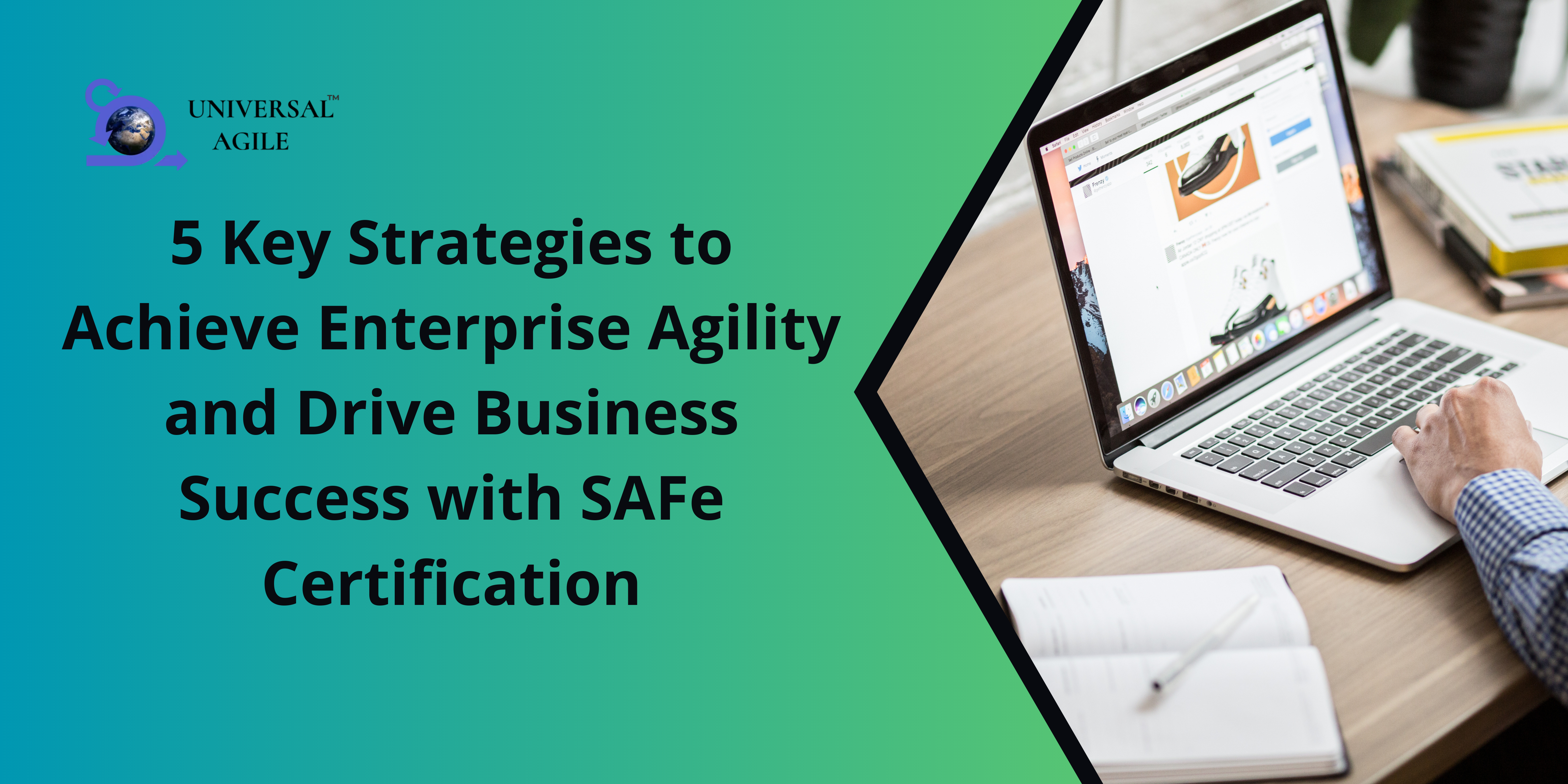5 Key Strategies to Achieve Enterprise Agility and Drive Business Success with SAFe Certification
Introduction
In today’s rapidly evolving business landscape, organizations are constantly seeking ways to adapt, innovate, and stay ahead of the competition. One proven approach to achieving enterprise agility and driving business success is through the implementation of the Scaled Agile Framework (SAFe) and obtaining SAFe certification. In this article, we will explore five key strategies that can help organizations leverage SAFe certification to unlock their full potential, foster agility, and propel their business forward.
1. Embrace the SAFe Mindset
To effectively implement SAFe and reap its benefits, organizations must embrace the SAFe mindset. This involves fostering a culture of collaboration, continuous improvement, and customer-centricity. With SAFe, teams are encouraged to work together, break down silos, and align their efforts toward shared goals. By embracing the SAFe mindset, organizations can create an environment where agility thrives, and teams can adapt and respond quickly to changing market conditions.
2. Establish Agile Release Trains (ARTs)
At the heart of SAFe lies the concept of Agile Release Trains (ARTs). ARTs are long-lived teams of agile teams that operate on a fixed schedule known as the Program Increment (PI). These cross-functional teams collaborate to deliver value to the customers consistently and predictably. By establishing ARTs, organizations can achieve improved alignment, synchronization, and faster time-to-market. SAFe certification equips individuals with the necessary skills to lead and facilitate these ARTs effectively.
- Creating High-Performing ARTs
Creating high-performing ARTs requires careful planning and execution. It is important to form teams with individuals possessing diverse skill sets and expertise. SAFe certification provides professionals with the knowledge and tools to build and nurture high-performing ARTs. By leveraging the principles and practices of SAFe, organizations can optimize their ARTs, foster innovation, and deliver exceptional value to their customers.
- ART Metrics and Continuous Improvement
To ensure the success of ARTs, organizations must establish metrics to measure their performance and progress. SAFe certification equips professionals with the ability to identify key metrics, track ART performance, and make data-driven decisions. Regular retrospectives and continuous improvement initiatives enable organizations to learn from their experiences, adapt their processes, and drive incremental enhancements to their ARTs.
3. Implement Lean-Agile Leadership
Effective leadership is instrumental in driving organizational agility and success. SAFe certification empowers leaders with the knowledge and skills needed to become Lean-Agile leaders. These leaders play a crucial role in inspiring and guiding teams, fostering a culture of innovation, and enabling the adoption of SAFe practices throughout the organization. By embracing Lean-Agile leadership principles, organizations can create an environment where individuals are empowered, collaboration is encouraged, and innovation flourishes.
4. Foster Continuous Learning and Improvement
In the rapidly changing business landscape, organizations must foster a culture of continuous learning and improvement. SAFe certification provides professionals with the necessary tools and techniques to drive continuous improvement initiatives. By regularly evaluating processes, identifying areas for enhancement, and implementing iterative changes, organizations can evolve and adapt to meet the demands of the market effectively. SAFe certification equips individuals with the skills to facilitate and lead these improvement efforts.
5. Leverage SAFe for Business Agility
SAFe certification equips individuals with the knowledge and expertise to leverage SAFe for achieving business agility. By implementing SAFe practices, organizations can enhance their ability to adapt to changing market dynamics, embrace innovation, and capitalize on emerging opportunities. Here are some ways organizations can leverage SAFe for business agility:
- Portfolio Management and Value Streams
SAFe emphasizes the importance of portfolio management and value streams. Organizations can utilize SAFe certification to develop a clear understanding of their portfolio of projects, initiatives, and investments. By identifying value streams and aligning them with business objectives, organizations can prioritize efforts, allocate resources effectively, and deliver value to customers more efficiently.
- Agile Product Development and Release Planning
SAFe guides agile product development and release planning. Through SAFe certification, professionals gain insights into techniques for effective backlog management, iterative development, and incremental delivery. By embracing SAFe’s product development approach, organizations can reduce time-to-market, gather customer feedback early, and adapt their products to meet evolving customer needs.
- Lean-Agile Procurement and Vendor Management
Procurement and vendor management play a critical role in organizational success. SAFe certification equips professionals with the skills to incorporate Lean-Agile principles into procurement processes. By fostering collaborative relationships with vendors, organizations can leverage their expertise, optimize supplier selection, and enhance the overall value delivery chain.
Conclusion
In today’s fast-paced business landscape, achieving enterprise agility is a key driver of success. By leveraging the Scaled Agile Framework (SAFe) and obtaining SAFe certification, organizations can unlock their full potential, foster collaboration, and respond swiftly to market changes. The strategies outlined in this article include embracing the SAFe mindset, establishing Agile Release Trains (ARTs), implementing Lean-Agile leadership, fostering continuous learning, and leveraging SAFe for business agility, and providing a roadmap for organizations seeking to drive business success through SAFe certification. With a commitment to implementing these strategies and investing in SAFe certification, organizations can position themselves as leaders in their industry, delivering exceptional value to their customers and leaving their competition behind.
FAQs
Q1: What is SAFe certification?
SAFe certification stands for Scaled Agile Framework certification. It validates an individual’s understanding and proficiency in implementing the SAFe methodology to achieve enterprise agility.
Q2: How can SAFe certification help drive business success?
SAFe certification equips individuals and organizations with the knowledge and skills to implement agile practices at scale, enabling faster value delivery, improved collaboration, and better alignment with business goals.
Q3: Is SAFe certification applicable to all industries?
Yes, SAFe certification applies to organizations across various industries, including software development, healthcare, finance, manufacturing, and more. The principles and practices of SAFe can be tailored and implemented to suit the specific needs and context of different industries.
Q4: How long does it take to obtain SAFe certification?
The duration to obtain SAFe certification depends on the level of certification you are pursuing. There are different certifications, such as SAFe Agilist, LPM, SAFe Product Owner/Product Manager (POPM). The certification programs typically involve training, studying, and passing an exam. The duration can range from a few days for basic certifications to several weeks for more advanced levels.




